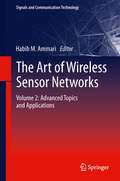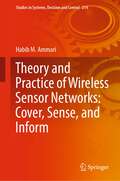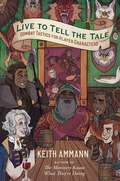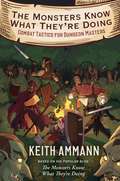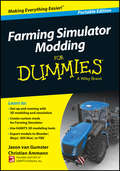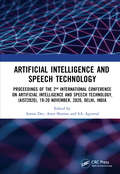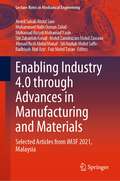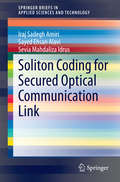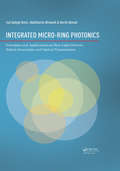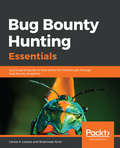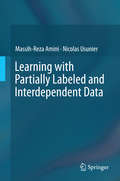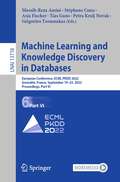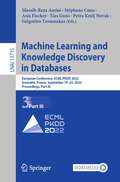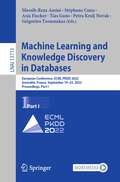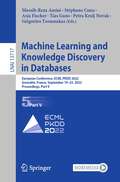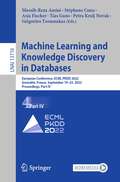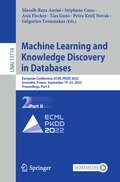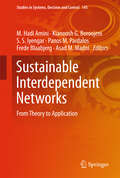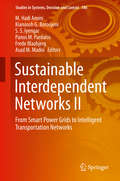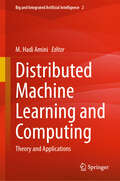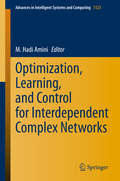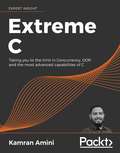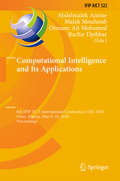- Table View
- List View
The Art of Wireless Sensor Networks
by Habib M. AmmariDuring the last one and a half decades, wireless sensor networks have witnessed significant growth and tremendous development in both academia and industry. "The Art of Wireless Sensor Networks: Volume 1: Fundamentals" focuses on the fundamentals concepts in the design, analysis, and implementation of wireless sensor networks. It covers the various layers of the lifecycle of this type of network from the physical layer up to the application layer. Its rationale is that the first volume covers contemporary design issues, tools, and protocols for radio-based two-dimensional terrestrial sensor networks. All the book chapters in this volume include up-to-date research work spanning various classic facets of the physical properties and functional behavior of wireless sensor networks, including physical layer, medium access control, data routing, topology management, mobility management, localization, task management, data management, data gathering, security, middleware, sensor technology, standards, and operating systems. This book will be an excellent source of information for both senior undergraduate and graduate students majoring in computer science, computer engineering, electrical engineering, or any related discipline. In addition, computer scientists, researchers, and practitioners in both academia and industry will find this book useful and interesting.
Theory and Practice of Wireless Sensor Networks: Cover, Sense, and Inform (Studies in Systems, Decision and Control #214)
by Habib M. AmmariThis book aims at developing a reader’s thorough understanding of the challenges and opportunities of two categories of networks, namely k-covered wireless sensor networks and k-barrier covered wireless sensor networks. It presents a variety of theoretical studies based on percolation theory, convexity theory, and applied computational geometry, as well as the algorithms and protocols that are essential to their design, analysis, and development. Particularly, this book focuses on the cover, sense, and inform (CSI) paradigm with a goal to build a unified framework, where connected k-coverage (or k-barrier coverage), sensor scheduling, and geographic data forwarding, gathering, and delivery are jointly considered. It provides the interested reader with a fine study of the above networks, which can be covered in introductory and advanced courses on wireless sensor networks. This book is useful to senior undergraduate and graduate students in computer science, computer engineering, electrical engineering, information science, information technology, mathematics, and any related discipline. Also, it is of interest to computer scientists, researchers, and practitioners in academia and industry with interest in these two networks from their deployment until data gathering and delivery.
Live to Tell the Tale: Combat Tactics for Player Characters (The Monsters Know What They’re Doing #2)
by Keith AmmannFrom the author of The Monsters Know What They&’re Doing comes an introduction to combat tactics for Dungeons & Dragons players.In his first book, The Monsters Know What They&’re Doing (based on his popular blog), Keith Ammann unleashed upon the D&D world a wave of clever, highly evolved monster tactics. Now it&’s only fair that he gives players the tools they need to fight back…and prevail! An introduction to combat tactics for fifth-edition Dungeons & Dragons players, Live to Tell the Tale evens the score. It examines the fundamentals of D&D battles: combat roles, party composition, attacking combos, advantage and disadvantage, Stealth and Perception, and more…including the ever-important consideration of how to run away! Don&’t worry about creating a mathematically perfect character from square one. Survival isn&’t about stats—it&’s about behavior! With four turn-by-turn, roll-by-roll, blow-by-blow sample battles, Live to Tell the Tale breaks down how to make the best choices for your cherished characters so that they can survive their adventures, retire upon their accumulated riches, and tell stories about the old days that nobody will ever believe.
The Monsters Know What They're Doing: Combat Tactics for Dungeon Masters (The Monsters Know What They’re Doing #1)
by Keith AmmannFrom the creator of the popular blog The Monsters Know What They&’re Doing comes a compilation of villainous battle plans for Dungeon Masters.In the course of a Dungeons & Dragons game, a Dungeon Master has to make one decision after another in response to player behavior—and the better the players, the more unpredictable their behavior! It&’s easy for even an experienced DM to get bogged down in on-the-spot decision-making or to let combat devolve into a boring slugfest, with enemies running directly at the player characters and biting, bashing, and slashing away. In The Monsters Know What They&’re Doing, Keith Ammann lightens the DM&’s burden by helping you understand your monsters&’ abilities and develop battle plans before your fifth edition D&D game session begins. Just as soldiers don&’t whip out their field manuals for the first time when they&’re already under fire, a DM shouldn&’t wait until the PCs have just encountered a dozen bullywugs to figure out how they advance, fight, and retreat. Easy to read and apply, The Monsters Know What They're Doing is essential reading for every DM.
Farming Simulator Modding For Dummies
by Christian Ammann Jason Van GumsterLearn the basics of 3D modeling for the popular Farming Simulator gameDo you want to get started with creating your own vehicles, maps, landscapes, and tools that you can use in the game and share with the Farming Simulator community? Then this is the resource for you! With the help of Jason van Gumster, you'll get up and running on everything you need to master 3D modeling and simulation--and have fun while doing it! Inside, you'll find out how to create and edit maps, start using the material panel, customize your mods by adding texture, use the correct file-naming conventions, test your mod in single and multiplayer modes, get a grip on using Vehicle XML, and so much more.There's no denying that Farming Simulator players love modding--and now there's a trusted, friendly resource to help you take your modding skills to the next level and get even more out of your game. Written in plain English and packed with tons of step-by-step explanations, Farming Simulator Modding For Dummies is a great way to learn the ropes of 3D modeling with the tools available to you in the game. In no time, you'll be wowing your fellow gamesters--and yourself--with custom, kick-butt mods. So what are you waiting for?Includes an easy-to-follow introduction to using the GIANTS 3D modeling toolsExplains how to export models to Blender, Maya, 3DS Max, or FBXProvides tips for using the correct image format for texturesDetails how to use Photoshop and Audacity to create custom mods for Farming SimulatorWhether you're one of the legions of rabid fans of the popular Farming Simulator game or just someone who wants to learn the basics of 3D modeling and animation, you'll find everything you need in this handy guide.
Trustworthy AI: A Business Guide for Navigating Trust and Ethics in AI
by Beena AmmanathAn essential resource on artificial intelligence ethics for business leaders In Trustworthy AI, award-winning executive Beena Ammanath offers a practical approach for enterprise leaders to manage business risk in a world where AI is everywhere by understanding the qualities of trustworthy AI and the essential considerations for its ethical use within the organization and in the marketplace. The author draws from her extensive experience across different industries and sectors in data, analytics and AI, the latest research and case studies, and the pressing questions and concerns business leaders have about the ethics of AI. Filled with deep insights and actionable steps for enabling trust across the entire AI lifecycle, the book presents: In-depth investigations of the key characteristics of trustworthy AI, including transparency, fairness, reliability, privacy, safety, robustness, and more A close look at the potential pitfalls, challenges, and stakeholder concerns that impact trust in AI application Best practices, mechanisms, and governance considerations for embedding AI ethics in business processes and decision making Written to inform executives, managers, and other business leaders, Trustworthy AI breaks new ground as an essential resource for all organizations using AI.
Artificial Intelligence and Speech Technology: Proceedings of the 2nd International Conference on Artificial Intelligence and Speech Technology, (AIST2020), 19-20 November, 2020, Delhi, India
by Amita Dev, Arun Sharma, and S. S. AgrawalThe 2nd International Conference on Artificial Intelligence and Speech Technology (AIST2020) was organized by Indira Gandhi Delhi Technical University for Women, Delhi, India on November 19–20, 2020. AIST2020 is dedicated to cutting-edge research that addresses the scientific needs of academic researchers and industrial professionals to explore new horizons of knowledge related to Artificial Intelligence and Speech Technologies. AIST2020 includes high-quality paper presentation sessions revealing the latest research findings, and engaging participant discussions. The main focus is on novel contributions which would open new opportunities for providing better and low-cost solutions for the betterment of society. These include the use of new AI-based approaches like Deep Learning, CNN, RNN, GAN, and others in various Speech related issues like speech synthesis, speech recognition, etc.
Enabling Industry 4.0 through Advances in Manufacturing and Materials: Selected Articles from iM3F 2021, Malaysia (Lecture Notes in Mechanical Engineering)
by Amiril Sahab Abdul Sani Muhammed Nafis Osman Zahid Mohamad Rusydi Mohamad Yasin Siti Zubaidah Ismail Mohd Zairulnizam Mohd Zawawi Ahmad Rosli Abdul Manaf Siti Nadiah Mohd Saffe Radhiyah Abd Aziz Faiz Mohd TuranThis book presents part of the proceedings of the Manufacturing and Materials track of the iM3F 2021 conference held in Malaysia. This collection of articles deliberates on the key challenges and trends related to manufacturing as well as materials engineering and technology in setting the stage for the world in embracing the Fourth Industrial Revolution. It presents recent findings with regard to manufacturing and materials that are pertinent toward the realizations and ultimately the embodiment of Industry 4.0, with contributions from both industry and academia.
Beginning ArcGIS for Desktop Development using .NET
by Pouria AmirianGet the very most out of the ArcGIS for Desktop products through ArcObjects and .NETArcGIS for Desktop is a powerful suite of software tools for creating and using maps, compiling, analyzing and sharing geographic information, using maps and geographic information in applications, and managing geographic databases. But getting the hang of ArcGIS for Desktop can be a bit tricky, even for experienced programmers. Core components of ArcGIS platform is called ArcObjects. This book first introduce you the whole ArcGIS platform and the opportunities for development using various programming languages. Then it focuses on ArcGIS for Desktop applications and makes you familiar with ArcObjects from .NET point of view. Whether you are an ArcGIS user with no background in programming or a programmer without experience with the ArcGIS platform, this book arms you with everything you need to get going with ArcGIS for Desktop development using .NET?right away. Written by a leading expert in geospatial information system design and development, it provides concise, step-by-step guidance, illustrated with best-practices examples, along with plenty of ready-to-use source code. In no time you?ll progress from .NET programming basics to understanding the full suite of ArcGIS tools and artefacts to customising and building your own commands, tools and extensions?all the way through application deployment. Among other things, you?ll learn to:Object-Oriented and Interface-based programming in .NET (C# and VB.NET) Finding relationship between classes and interfaces using object model diagramsQuerying dataVisualizing geographical data using various renderingCreating various kinds of Desktop Add-Ins Performing foreground and background geoprocessingLearn how to improve your productivity with ArcGIS for Desktop and Beginning ArcGIS for Desktop Development Using .NET
Soliton Coding for Secured Optical Communication Link
by Iraj Sadegh Amiri Sayed Ehsan Alavi Sevia Mahdaliza IdrusNonlinear behavior of light such as chaos can be observed during propagation of a laser beam inside the microring resonator (MRR) systems. This Brief highlights the design of a system of MRRs to generate a series of logic codes. An optical soliton is used to generate an entangled photon. The ultra-short soliton pulses provide the required communication signals to generate a pair of polarization entangled photons required for quantum keys. In the frequency domain, MRRs can be used to generate optical millimetre-wave solitons with a broadband frequency of 0-100 GHz. The soliton signals are multiplexed and modulated with the logic codes to transmit the data via a network system. The soliton carriers play critical roles to transmit the data via an optical communication link and provide many applications in secured optical communications. Therefore, transmission of data information can be performed via a communication network using soliton pulse carriers. A system known as optical multiplexer can be used to increase the channel capacity and security of the signals.
Integrated Micro-Ring Photonics: Principles and Applications as Slow Light Devices, Soliton Generation and Optical Transmission
by Iraj Sadegh Amiri Abdolkarim Afroozeh Harith AhmadMicro-ring resonators (MRRs) are employed to generate signals used for optical communication applications, where they can be integrated in a single system. These structures are ideal candidates for very large-scale integrated (VLSI) photonic circuits, since they provide a wide range of optical signal processing functions while being ultra-compact. Soliton pulses have sufficient stability for preservation of their shape and velocity. Technological progress in fields such as tunable narrow band laser systems, multiple transmission, and MRR systems constitute a base for the development of new transmission techniques. Controlling the speed of a light signal has many potential applications in fiber optic communication and quantum computing. The slow light effect has many important applications and is a key technology for all optical networks such as optical signal processing. Generation of slow light in MRRs is based on the nonlinear optical fibers. Slow light can be generated within the micro-ring devices, which will be able to be used with the mobile telephone. Therefore, the message can be kept encrypted via quantum cryptography. Thus perfect security in a mobile telephone network is plausible. This research study involves both numerical experiments and theoretical work based on MRRs for secured communication.
Bug Bounty Hunting Essentials
by Shahmeer AmirThis book is targeted towards white-hat hackers, or anyone who wants to understand the concept behind bug bounty hunting and understand this brilliant way of penetration testing. This book does not require any knowledge on bug bounty hunting.
Learning with Partially Labeled and Interdependent Data
by Massih-Reza Amini Nicolas UsunierThis book develops two key machine learning principles: the semi-supervised paradigm and learning with interdependent data. It reveals new applications, primarily web related, that transgress the classical machine learning framework through learning with interdependent data. The book traces how the semi-supervised paradigm and the learning to rank paradigm emerged from new web applications, leading to a massive production of heterogeneous textual data. It explains how semi-supervised learning techniques are widely used, but only allow a limited analysis of the information content and thus do not meet the demands of many web-related tasks. Later chapters deal with the development of learning methods for ranking entities in a large collection with respect to precise information needed. In some cases, learning a ranking function can be reduced to learning a classification function over the pairs of examples. The book proves that this task can be efficiently tackled in a new framework: learning with interdependent data. Researchers and professionals in machine learning will find these new perspectives and solutions valuable. Learning with Partially Labeled and Interdependent Data is also useful for advanced-level students of computer science, particularly those focused on statistics and learning.
Machine Learning and Knowledge Discovery in Databases: European Conference, ECML PKDD 2022, Grenoble, France, September 19–23, 2022, Proceedings, Part VI (Lecture Notes in Computer Science #13718)
by Massih-Reza Amini Petra Kralj Novak Grigorios Tsoumakas Stéphane Canu Asja Fischer Tias GunsThe multi-volume set LNAI 13713 until 13718 constitutes the refereed proceedings of the European Conference on Machine Learning and Knowledge Discovery in Databases, ECML PKDD 2022, which took place in Grenoble, France, in September 2022.The 236 full papers presented in these proceedings were carefully reviewed and selected from a total of 1060 submissions. In addition, the proceedings include 17 Demo Track contributions. The volumes are organized in topical sections as follows: Part I: Clustering and dimensionality reduction; anomaly detection; interpretability and explainability; ranking and recommender systems; transfer and multitask learning; Part II: Networks and graphs; knowledge graphs; social network analysis; graph neural networks; natural language processing and text mining; conversational systems; Part III: Deep learning; robust and adversarial machine learning; generative models; computer vision; meta-learning, neural architecture search; Part IV: Reinforcement learning; multi-agent reinforcement learning; bandits and online learning; active and semi-supervised learning; private and federated learning; . Part V: Supervised learning; probabilistic inference; optimal transport; optimization; quantum, hardware; sustainability; Part VI: Time series; financial machine learning; applications; applications: transportation; demo track.
Machine Learning and Knowledge Discovery in Databases: European Conference, ECML PKDD 2022, Grenoble, France, September 19–23, 2022, Proceedings, Part III (Lecture Notes in Computer Science #13715)
by Massih-Reza Amini Stéphane Canu Asja Fischer Tias Guns Petra Kralj Novak Grigorios TsoumakasThe multi-volume set LNAI 13713 until 13718 constitutes the refereed proceedings of the European Conference on Machine Learning and Knowledge Discovery in Databases, ECML PKDD 2022, which took place in Grenoble, France, in September 2022.The 236 full papers presented in these proceedings were carefully reviewed and selected from a total of 1060 submissions. In addition, the proceedings include 17 Demo Track contributions. The volumes are organized in topical sections as follows: Part I: Clustering and dimensionality reduction; anomaly detection; interpretability and explainability; ranking and recommender systems; transfer and multitask learning; Part II: Networks and graphs; knowledge graphs; social network analysis; graph neural networks; natural language processing and text mining; conversational systems; Part III: Deep learning; robust and adversarial machine learning; generative models; computer vision; meta-learning, neural architecture search; Part IV: Reinforcement learning; multi-agent reinforcement learning; bandits and online learning; active and semi-supervised learning; private and federated learning; . Part V: Supervised learning; probabilistic inference; optimal transport; optimization; quantum, hardware; sustainability; Part VI: Time series; financial machine learning; applications; applications: transportation; demo track.
Machine Learning and Knowledge Discovery in Databases: European Conference, ECML PKDD 2022, Grenoble, France, September 19–23, 2022, Proceedings, Part I (Lecture Notes in Computer Science #13713)
by Massih-Reza Amini Stéphane Canu Asja Fischer Tias Guns Petra Kralj Novak Grigorios TsoumakasThe multi-volume set LNAI 13713 until 13718 constitutes the refereed proceedings of the European Conference on Machine Learning and Knowledge Discovery in Databases, ECML PKDD 2022, which took place in Grenoble, France, in September 2022.The 236 full papers presented in these proceedings were carefully reviewed and selected from a total of 1060 submissions. In addition, the proceedings include 17 Demo Track contributions. The volumes are organized in topical sections as follows: Part I: Clustering and dimensionality reduction; anomaly detection; interpretability and explainability; ranking and recommender systems; transfer and multitask learning; Part II: Networks and graphs; knowledge graphs; social network analysis; graph neural networks; natural language processing and text mining; conversational systems; Part III: Deep learning; robust and adversarial machine learning; generative models; computer vision; meta-learning, neural architecture search; Part IV: Reinforcement learning; multi-agent reinforcement learning; bandits and online learning; active and semi-supervised learning; private and federated learning; . Part V: Supervised learning; probabilistic inference; optimal transport; optimization; quantum, hardware; sustainability; Part VI: Time series; financial machine learning; applications; applications: transportation; demo track.
Machine Learning and Knowledge Discovery in Databases: European Conference, ECML PKDD 2022, Grenoble, France, September 19–23, 2022, Proceedings, Part V (Lecture Notes in Computer Science #13717)
by Massih-Reza Amini Stéphane Canu Asja Fischer Tias Guns Petra Kralj Novak Grigorios TsoumakasThe multi-volume set LNAI 13713 until 13718 constitutes the refereed proceedings of the European Conference on Machine Learning and Knowledge Discovery in Databases, ECML PKDD 2022, which took place in Grenoble, France, in September 2022.The 236 full papers presented in these proceedings were carefully reviewed and selected from a total of 1060 submissions. In addition, the proceedings include 17 Demo Track contributions. The volumes are organized in topical sections as follows: Part I: Clustering and dimensionality reduction; anomaly detection; interpretability and explainability; ranking and recommender systems; transfer and multitask learning; Part II: Networks and graphs; knowledge graphs; social network analysis; graph neural networks; natural language processing and text mining; conversational systems; Part III: Deep learning; robust and adversarial machine learning; generative models; computer vision; meta-learning, neural architecture search; Part IV: Reinforcement learning; multi-agent reinforcement learning; bandits and online learning; active and semi-supervised learning; private and federated learning; . Part V: Supervised learning; probabilistic inference; optimal transport; optimization; quantum, hardware; sustainability; Part VI: Time series; financial machine learning; applications; applications: transportation; demo track.
Machine Learning and Knowledge Discovery in Databases: European Conference, ECML PKDD 2022, Grenoble, France, September 19–23, 2022, Proceedings, Part IV (Lecture Notes in Computer Science #13716)
by Massih-Reza Amini Stéphane Canu Asja Fischer Tias Guns Petra Kralj Novak Grigorios TsoumakasThe multi-volume set LNAI 13713 until 13718 constitutes the refereed proceedings of the European Conference on Machine Learning and Knowledge Discovery in Databases, ECML PKDD 2022, which took place in Grenoble, France, in September 2022.The 236 full papers presented in these proceedings were carefully reviewed and selected from a total of 1060 submissions. In addition, the proceedings include 17 Demo Track contributions. The volumes are organized in topical sections as follows: Part I: Clustering and dimensionality reduction; anomaly detection; interpretability and explainability; ranking and recommender systems; transfer and multitask learning; Part II: Networks and graphs; knowledge graphs; social network analysis; graph neural networks; natural language processing and text mining; conversational systems; Part III: Deep learning; robust and adversarial machine learning; generative models; computer vision; meta-learning, neural architecture search; Part IV: Reinforcement learning; multi-agent reinforcement learning; bandits and online learning; active and semi-supervised learning; private and federated learning; Part V: Supervised learning; probabilistic inference; optimal transport; optimization; quantum, hardware; sustainability; Part VI: Time series; financial machine learning; applications; applications: transportation; demo track.
Machine Learning and Knowledge Discovery in Databases: European Conference, ECML PKDD 2022, Grenoble, France, September 19–23, 2022, Proceedings, Part II (Lecture Notes in Computer Science #13714)
by Massih-Reza Amini Stéphane Canu Asja Fischer Tias Guns Petra Kralj Novak Grigorios TsoumakasThe multi-volume set LNAI 13713 until 13718 constitutes the refereed proceedings of the European Conference on Machine Learning and Knowledge Discovery in Databases, ECML PKDD 2022, which took place in Grenoble, France, in September 2022.The 236 full papers presented in these proceedings were carefully reviewed and selected from a total of 1060 submissions. In addition, the proceedings include 17 Demo Track contributions. The volumes are organized in topical sections as follows: Part I: Clustering and dimensionality reduction; anomaly detection; interpretability and explainability; ranking and recommender systems; transfer and multitask learning; Part II: Networks and graphs; knowledge graphs; social network analysis; graph neural networks; natural language processing and text mining; conversational systems; Part III: Deep learning; robust and adversarial machine learning; generative models; computer vision; meta-learning, neural architecture search; Part IV: Reinforcement learning; multi-agent reinforcement learning; bandits and online learning; active and semi-supervised learning; private and federated learning; . Part V: Supervised learning; probabilistic inference; optimal transport; optimization; quantum, hardware; sustainability; Part VI: Time series; financial machine learning; applications; applications: transportation; demo track.
Sustainable Interdependent Networks: From Theory To Application (Studies In Systems, Decision And Control #145)
by M. Hadi Amini Kianoosh G. Boroojeni S. S. Iyengar Panos M. Pardalos Frede Blaabjerg Asad M. MadniThis book focuses on the theory and application of interdependent networks. The contributors consider the influential networks including power and energy networks, transportation networks, and social networks. The first part of the book provides the next generation sustainability framework as well as a comprehensive introduction of smart cities with special emphasis on energy, communication, data analytics and transportation. The second part offers solutions to performance and security challenges of developing interdependent networks in terms of networked control systems, scalable computation platforms, and dynamic social networks. The third part examines the role of electric vehicles in the future of sustainable interdependent networks. The fourth and last part of this volume addresses the promises of control and management techniques for the future power grids.
Sustainable Interdependent Networks II: From Smart Power Grids to Intelligent Transportation Networks (Studies in Systems, Decision and Control #186)
by M. Hadi Amini Kianoosh G. Boroojeni S. S. Iyengar Panos M. Pardalos Frede Blaabjerg Asad M. MadniThis book paves the way for researchers working on the sustainable interdependent networks spread over the fields of computer science, electrical engineering, and smart infrastructures. It provides the readers with a comprehensive insight to understand an in-depth big picture of smart cities as a thorough example of interdependent large-scale networks in both theory and application aspects. The contributors specify the importance and position of the interdependent networks in the context of developing the sustainable smart cities and provide a comprehensive investigation of recently developed optimization methods for large-scale networks. There has been an emerging concern regarding the optimal operation of power and transportation networks. In the second volume of Sustainable Interdependent Networks book, we focus on the interdependencies of these two networks, optimization methods to deal with the computational complexity of them, and their role in future smart cities. We further investigate other networks, such as communication networks, that indirectly affect the operation of power and transportation networks. Our reliance on these networks as global platforms for sustainable development has led to the need for developing novel means to deal with arising issues. The considerable scale of such networks, due to the large number of buses in smart power grids and the increasing number of electric vehicles in transportation networks, brings a large variety of computational complexity and optimization challenges. Although the independent optimization of these networks lead to locally optimum operation points, there is an exigent need to move towards obtaining the globally-optimum operation point of such networks while satisfying the constraints of each network properly. The book is suitable for senior undergraduate students, graduate students interested in research in multidisciplinary areas related to future sustainable networks, and the researchers working in the related areas. It also covers the application of interdependent networks which makes it a perfect source of study for audience out of academia to obtain a general insight of interdependent networks.
Distributed Machine Learning and Computing: Theory and Applications (Big and Integrated Artificial Intelligence #2)
by M. Hadi AminiThis book focuses on a wide range of distributed machine learning and computing algorithms and their applications in healthcare and engineering systems. The contributors explore how these techniques can be applied to different real-world problems. It is suitable for students and researchers interested in conducting research in multidisciplinary areas that rely on distributed machine learning and computing techniques.
Optimization, Learning, and Control for Interdependent Complex Networks (Advances in Intelligent Systems and Computing #1123)
by M. Hadi AminiThis book focuses on a wide range of optimization, learning, and control algorithms for interdependent complex networks and their role in smart cities operation, smart energy systems, and intelligent transportation networks. It paves the way for researchers working on optimization, learning, and control spread over the fields of computer science, operation research, electrical engineering, civil engineering, and system engineering. This book also covers optimization algorithms for large-scale problems from theoretical foundations to real-world applications, learning-based methods to enable intelligence in smart cities, and control techniques to deal with the optimal and robust operation of complex systems. It further introduces novel algorithms for data analytics in large-scale interdependent complex networks. • Specifies the importance of efficient theoretical optimization and learning methods in dealing with emerging problems in the context of interdependent networks • Provides a comprehensive investigation of advance data analytics and machine learning algorithms for large-scale complex networks • Presents basics and mathematical foundations needed to enable efficient decision making and intelligence in interdependent complex networks M. Hadi Amini is an Assistant Professor at the School of Computing and Information Sciences at Florida International University (FIU). He is also the founding director of Sustainability, Optimization, and Learning for InterDependent networks laboratory (solid lab). He received his Ph.D. and M.Sc. from Carnegie Mellon University in 2019 and 2015 respectively. He also holds a doctoral degree in Computer Science and Technology. Prior to that, he received M.Sc. from Tarbiat Modares University in 2013, and the B.Sc. from Sharif University of Technology in 2011.
Extreme C
by Kamran AminiExtreme C is for C programmers who want to dig deep into the language and its capabilities. It will help you make the most of the low-level control C gives you
Computational Intelligence and Its Applications: 6th IFIP TC 5 International Conference, CIIA 2018, Oran, Algeria, May 8-10, 2018, Proceedings (IFIP Advances in Information and Communication Technology #522)
by Abdelmalek Amine Malek Mouhoub Otmane Ait Mohamed Bachir DjebbarThis book constitutes the refereed proceedings of the 6th IFIP TC 5 International Conference on Computational Intelligence and Its Applications, CIIA 2018, held in Oran, Algeria, in May 2018.The 56 full papers presented were carefully reviewed and selected from 202 submissions. They are organized in the following topical sections: data mining and information retrieval; evolutionary computation; machine learning; optimization; planning and scheduling; wireless communication and mobile computing; Internet of Things (IoT) and decision support systems; pattern recognition and image processing; and semantic web services.
